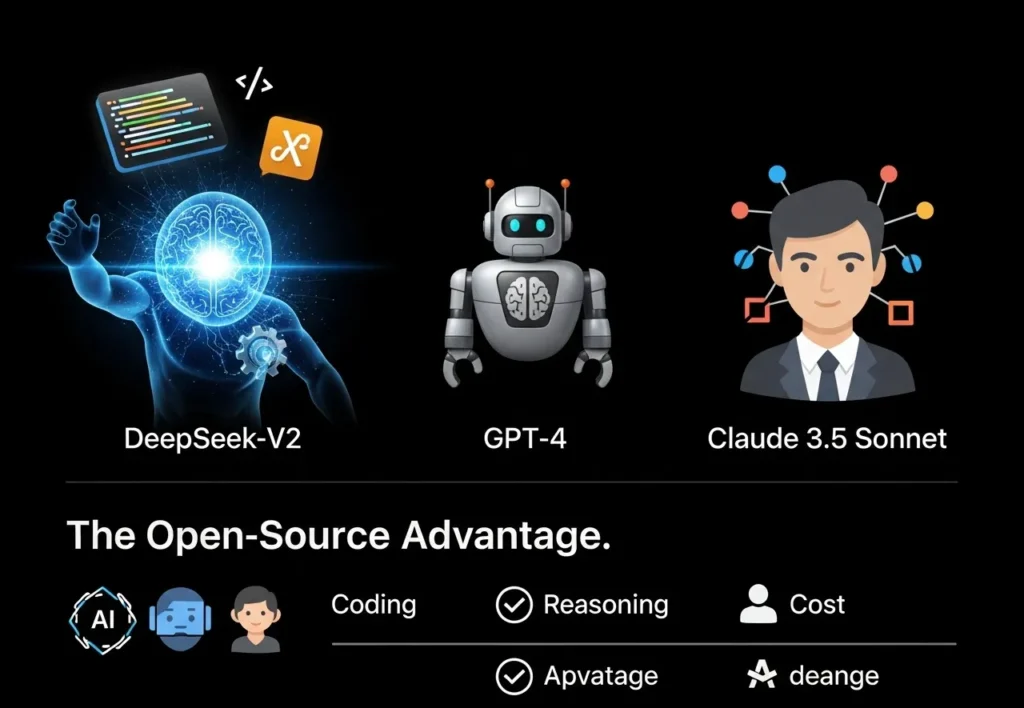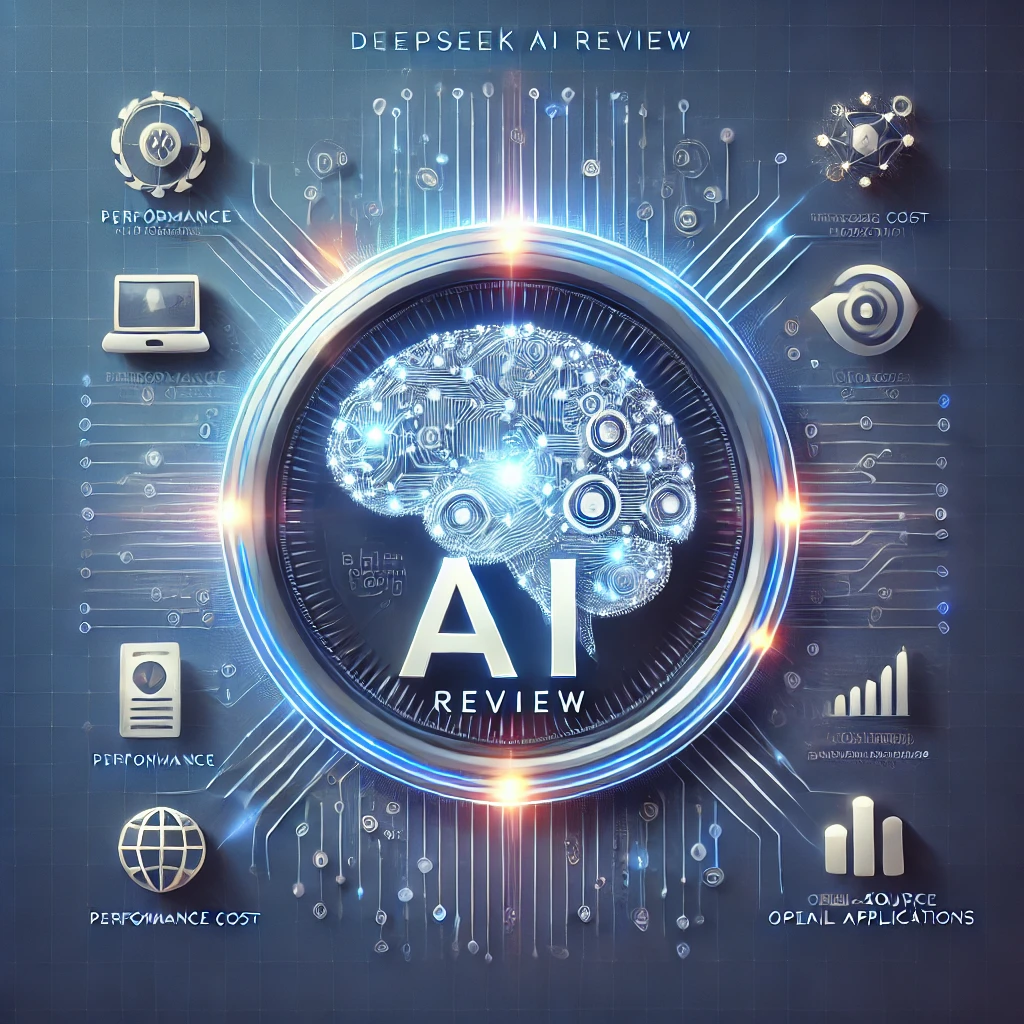In artificial intelligence, there’s a new name making waves: DeepSeek. This open-source AI model is gaining a reputation for its powerful performance, low cost, and impressive versatility. While many of us have become familiar with tools like ChatGPT, DeepSeek is emerging as a serious contender, especially for those who want more control and efficiency. But what exactly makes DeepSeek stand out in such a crowded field?
In this comprehensive guide, we’ll take a close look at DeepSeek AI. We’ll break down its innovative technology, compare its performance to the big players like GPT-4 and Claude, and help you understand if this open-source model is the right tool for your next project.
What is DeepSeek AI? A New Open-Source Challenger
DeepSeek is an open-source AI model designed to handle a wide range of tasks, from writing and creative content to complex coding and reasoning. Developed by a team in China, it has quickly drawn attention from developers and researchers worldwide. Unlike many proprietary, “black-box” models, DeepSeek is open-source, meaning its code is transparent and available for anyone to inspect, modify, and build upon.
The latest version, DeepSeek-V2, is built on a unique architecture that makes it both powerful and incredibly efficient. This transparency and innovation are key reasons why DeepSeek is considered a major disruptor in the AI world.
The Technology Under the Hood: DeepSeek’s Core Innovations
DeepSeek isn’t just another language model; it’s built differently from the ground up. Two core innovations allow it to achieve high performance with a lower computational cost.
Mixture of Experts (MoE) Architecture
At its core, DeepSeek-V2 uses a Mixture of Experts (MoE) architecture. Think of it like a team of specialized workers. Instead of one massive, all-knowing brain that has to work on every task, the MoE model is made up of many smaller, specialized “experts.” When you give DeepSeek a task—say, writing a Python function—the model intelligently activates only the most relevant experts for that job.
This approach is incredibly efficient. It allows the model to be very large (with hundreds of billions of parameters) but only requires a fraction of that power for any given request. This leads to faster processing and, most importantly, much lower costs compared to traditional, dense models like GPT-4, which use almost all of their parameters every time.
Multi-Layer Attention (MLA)
Another key feature is its Multi-Layer Attention (MLA) mechanism. This is a technical term for how the model pays attention to context. Imagine trying to solve a math problem that requires you to remember a formula you read three pages ago. MLA helps DeepSeek do just that, allowing it to process information and maintain context over long documents or complex conversations more effectively. This is crucial for tasks like writing a long article or debugging a complex piece of code where a deep understanding of the entire text is needed.
Head-to-Head: DeepSeek’s Performance and Benchmarks
Benchmarks and real-world testing show that DeepSeek-V2 isn’t only a budget option; it’s a genuine competitor to the best AI models on the market.
DeepSeek-V2 vs. GPT-4 and Claude 3.5 Sonnet
When we compare DeepSeek-V2 to industry giants like GPT-4 and Claude 3.5 Sonnet, the results are very impressive, especially in specific areas.

- Coding and Reasoning: DeepSeek truly shines here. On coding benchmarks like HumanEval and LiveCodeBench, it often performs at a comparable level to, and sometimes even surpasses, its closed-source rivals. Many developers have noted that DeepSeek’s code is often simpler and more straightforward, avoiding the “over-engineering” that some other models can default to. This makes it a fantastic tool for generating clean, functional code.
- Math and Logic: DeepSeek’s reasoning abilities are top-tier. On datasets like MATH-500, it consistently achieves high accuracy, demonstrating a strong grasp of logical and mathematical problem-solving.
- Cost and Efficiency: This is where DeepSeek-V2 has a clear advantage. Its MoE architecture makes it significantly more cost-effective to train and run. This allows businesses and developers to get high-quality results without the premium price tag associated with other models.
While models like GPT-4 and Claude might still hold an edge in broader, more creative tasks or have a larger general knowledge base, DeepSeek’s specialized performance in technical fields makes it a very powerful and efficient tool.
Cost and Accessibility: The DeepSeek Advantage
One of the biggest factors driving DeepSeek’s popularity is its cost-effectiveness. The open-source model is free to use, and when you run it through an API, the costs are often a fraction of what you would pay for a premium model. This is a game-changer for several reasons:
- For Small Businesses and Startups: It democratizes access to powerful AI technology. A small company can leverage DeepSeek’s capabilities for content creation, coding assistance, or customer support without a huge upfront investment.
- For Individual Developers: It provides a free, customizable tool for projects, experiments, and learning. The ability to run the model locally on your own hardware means you can work without worrying about API costs or data privacy.
- The Power of Open Source: As an open-source model, DeepSeek benefits from a global community of developers who are constantly improving, testing, and building on the core technology. This collaborative approach fosters rapid innovation and ensures the model continues to evolve.
Real-World Applications and Use Cases
DeepSeek’s versatility makes it a valuable tool for a wide range of users. Here are some of its most common applications.

For Developers and Programmers
DeepSeek-V2 is a fantastic coding assistant. It can:
- Write and Debug Code: Generate code snippets, complete functions, and even debug complex issues in multiple languages, including Python, JavaScript, and Java.
- Translate Code: Convert code from one programming language to another, saving valuable time on migration projects.
- Automate Repetitive Tasks: Create scripts or functions for recurring tasks, speeding up your workflow and allowing you to focus on more complex problems.
For Content Creators and Marketers
DeepSeek can be a powerful partner for anyone who creates content. It can help you:
- Generate Blog Posts and Articles: Outline topics, draft sections, or even write entire articles on a variety of subjects.
- Create Marketing Copy: Write social media captions, email newsletters, and product descriptions that are both engaging and effective.
- Summarize Information: Condense long articles, reports, or research papers into easy-to-read summaries, helping you stay on top of industry trends.
For Researchers and Educators
The model’s strong reasoning and logical abilities make it great for academic use. It can:
- Solve Complex Problems: Tackle advanced math problems or logical puzzles and show the step-by-step reasoning.
- Analyze Data: Process and interpret data, identify trends, and draft research findings.
- Create Educational Materials: Generate quizzes, tutorials, or study guides on various subjects.
Limitations and Challenges to Consider
While DeepSeek is a very impressive model, it’s not perfect. It’s important to be aware of its limitations before diving in.
Context Window
Although DeepSeek-V2 has a large context window, it can still be smaller than some of its competitors. This means it might struggle with incredibly long documents or extremely detailed conversations, where it might lose track of key information.
Potential for Language Mixing
As a model trained on both English and Chinese data, there is a possibility for it to mix languages in its responses, especially in more complex or open-ended tasks. This is a known issue the developers are actively working to improve.
Geopolitical and Data Privacy Concerns
As a model developed by a Chinese company, DeepSeek may face scrutiny regarding data privacy and security, especially from businesses and governments in other parts of the world. Users should be mindful of where and how they use the model, particularly with sensitive information.
Final Words
In this DeepSeek AI review, we’ve explored a powerful and promising open-source model that is truly shaking up the AI landscape. DeepSeek-V2, with its innovative Mixture of Experts architecture, offers a compelling combination of high performance and low cost. While it may have a few limitations, its strengths in coding, reasoning, and efficiency make it a formidable alternative to proprietary models like GPT-4.
Whether you’re a developer looking for a cost-effective coding partner, a writer seeking a powerful content assistant, or a business aiming to leverage AI without the high fees, DeepSeek is definitely worth exploring. It represents an exciting new chapter in the world of accessible and transparent artificial intelligence.
FAQs
Is DeepSeek AI suitable for beginners?
Yes, DeepSeek AI is beginner-friendly! Its user-friendly interface and clear documentation make it easy for newcomers to get started. Whether you’re a student, hobbyist, or professional, DeepSeek’s versatility allows you to use it for tasks like coding, writing, or learning without needing advanced technical skills. Plus, its open-source nature means there’s a supportive community to help you troubleshoot and learn.
Can DeepSeek AI handle multiple languages for coding and content creation?
Absolutely! DeepSeek AI supports multiple programming languages, including Python, JavaScript, Java, and more, making it a versatile tool for developers. For content creation, it can generate text in various languages, though its performance is strongest in English. If you’re working on multilingual projects, DeepSeek’s reasoning abilities and contextual understanding ensure high-quality results across different languages.
How does DeepSeek compare to GPT-4?
DeepSeek is more cost-effective and performs well on benchmarks like MATH-500 and HumanEval. However, it has a smaller context window and slower response times.
How does DeepSeek AI ensure data privacy and security?
DeepSeek AI takes data privacy seriously. As an open-source model, users can inspect the code to ensure there are no hidden vulnerabilities or data leaks. Additionally, DeepSeek allows users to run the model locally, meaning sensitive data doesn’t need to be sent to external servers. However, if you’re using a cloud-based version, it’s always a good idea to review the provider’s privacy policy and data handling practices.
Does DeepSeek AI require an internet connection to work?
Not necessarily! DeepSeek AI can be run locally on your device, meaning you don’t need an internet connection to use it. This is especially useful for users who prioritize data privacy or work in environments with limited connectivity. However, if you’re using a cloud-based version, an internet connection is required to access the model.
What industries can benefit the most from DeepSeek AI?
DeepSeek AI is highly versatile and can benefit a wide range of industries, including:
Software Development: For writing, debugging, and optimizing code.
Content Creation: For generating articles, social media posts, and marketing materials.
Education: For tutoring, solving math problems, and creating study materials.
Research: For drafting papers, analyzing data, and generating hypotheses.
Customer Support: For automating responses and improving service efficiency.
Its low cost and high performance make it accessible to startups, small businesses, and large enterprises alike.
Can DeepSeek AI be customized for specific tasks?
Yes, DeepSeek AI is highly customizable. Since it’s open-source, developers can modify the code to tailor the model for specific tasks or industries. For example, you can fine-tune DeepSeek to specialize in medical research, legal document analysis, or even creative writing. This flexibility makes it a powerful tool for businesses and individuals with unique needs.
What hardware is required to run DeepSeek AI locally?
Running DeepSeek AI locally requires a computer with a powerful GPU (Graphics Processing Unit) for optimal performance. While it can run on CPUs, the process will be slower. For most users, a modern GPU with at least 16GB of VRAM is recommended. If you’re unsure about your hardware, you can start with a cloud-based version to test the model before investing in local setup.
How does DeepSeek AI compare to other open-source AI models?
DeepSeek AI stands out among open-source AI models due to its Mixture of Experts (MoE) architecture, which allows it to handle specialized tasks more efficiently. Compared to models like LLaMA or Falcon, DeepSeek offers better cost-effectiveness and performance on benchmarks like MATH-500 and HumanEval. Its low training costs and open-source transparency also make it a preferred choice for developers and researchers.
Is DeepSeek AI capable of real-time collaboration?
Currently, DeepSeek AI does not natively support real-time collaboration features. However, developers can integrate it into collaborative platforms or tools like Google Docs or GitHub using APIs. This allows teams to leverage DeepSeek’s capabilities while working together on projects.
How often is DeepSeek AI updated?
The DeepSeek team regularly updates the model to improve performance, fix bugs, and add new features. As an open-source project, updates are often driven by community feedback and contributions. Users can stay informed about updates by following DeepSeek’s official GitHub repository or subscribing to their newsletter.
Can I use DeepSeek for free?
Yes, DeepSeek is open-source, meaning you can access and use it for free.
Conclusion
In this DeepSeek AI review, we’ve explored what makes this AI model a game-changer. From its innovative architecture to its real-world applications, DeepSeek offers a lot of value for users. While it has some limitations, its cost-effectiveness and open-source nature make it a strong contender in the AI landscape.
Whether you’re a developer, writer, or student, DeepSeek is worth checking out. This AI tool is a glimpse into the future of artificial intelligence.

